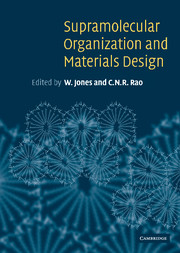Book contents
- Frontmatter
- Contents
- List of contributors
- Preface
- 1 Assembly and mineralization processes in biomineralization: strategies for forming biological composite materials
- 2 Mesoscale materials synthesis and beyond
- 3 Towards the rational design of zeolite frameworks
- 4 Mesoscale self-assembly: the assembly of micron-and millimeter-sized objects using capillary forces
- 5 Design of amphiphiles for the modulation of catalytic, membranous and gelation properties
- 6 Nanofabrication by the surface sol-gel process and molecular imprinting
- 7 The hierarchy of open-framework structures in metal phosphates and oxalates
- 8 Mesoscale self-assembly of metal nanocrystals into ordered arrays and giant clusters
- 9 Layered double hydroxides as templates for the formation of supramolecular structures
- 10 Molecular machines
- 11 Some aspects of supramolecular design of organic materials
- 12 Controlling crystal architecure in molecular solids: the supramolecular approach
- Index
6 - Nanofabrication by the surface sol-gel process and molecular imprinting
Published online by Cambridge University Press: 18 December 2009
- Frontmatter
- Contents
- List of contributors
- Preface
- 1 Assembly and mineralization processes in biomineralization: strategies for forming biological composite materials
- 2 Mesoscale materials synthesis and beyond
- 3 Towards the rational design of zeolite frameworks
- 4 Mesoscale self-assembly: the assembly of micron-and millimeter-sized objects using capillary forces
- 5 Design of amphiphiles for the modulation of catalytic, membranous and gelation properties
- 6 Nanofabrication by the surface sol-gel process and molecular imprinting
- 7 The hierarchy of open-framework structures in metal phosphates and oxalates
- 8 Mesoscale self-assembly of metal nanocrystals into ordered arrays and giant clusters
- 9 Layered double hydroxides as templates for the formation of supramolecular structures
- 10 Molecular machines
- 11 Some aspects of supramolecular design of organic materials
- 12 Controlling crystal architecure in molecular solids: the supramolecular approach
- Index
Summary
Introduction
Fabrication and nanostructural control of metal oxide thin films have been playing important roles in various areas of materials science. A thin surface oxide layer can give rise to excellent properties for materials. For example, improvement of abrasion resistance or lubricativity, chemical and mechanical stabilization, enhancement of hydrophilicity or water repellency can be achieved by forming thin oxide surfaces. Thin oxide layers with nanocontrolled structures are known to display advantages for designing unique chemical functions like specific adsorption of organic molecules, improved catalytic properties and capture of light energy.
High-vacuum dry-processes, such as chemical vapor deposition (CVD) and molecular beam epitaxy (MBE), have made it feasible to control precisely the thickness of metal oxide thin films. In these techniques, the preparative conditions like pressure and substrate temperature can be widely varied, and the elemental composition in individual atomic layers is controllable by sequential supply of precursor gases [1]. The dense, defect-less oxide films thus prepared are frequently used as underlayers of microelectronics devices.
On the other hand, the progress of wet-processes as preparative techniques of metal oxide films has been remarkable. The so-called soft solution process that provides oxide layers by means of electrochemical oxidation of a metal surface is expanding as a synthetic method of various mixed metal oxides with controlled thickness [2]. The two-dimensional (2D) sol-gel process based on the hydrolysis of metal alkoxides at the air/water interface has been reported as a preparative technique of ultrathin oxide films (Fig. 6.1a) [3].
- Type
- Chapter
- Information
- Supramolecular Organization and Materials Design , pp. 172 - 213Publisher: Cambridge University PressPrint publication year: 2001
- 6
- Cited by



